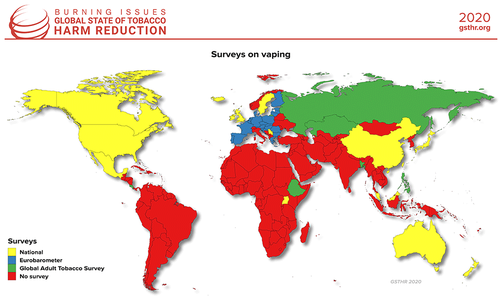Surveys on Vaping
Surveys on Vaping
Knowledge•Action•Change (2020)- Burning Issues: The Global State of Tobacco Harm Reduction 2020


Estimates of the prevalence of vaping are critical to measuring the uptake and coverage of THR. However, information on the prevalence of vaping is still scarce in many countries. WHO promotes the MPOWER tobacco control programme, the first letter of which refers to Monitoring. One of the key points of this is to collect up-to-date information on issues related to the use of tobacco and related products. Unfortunately, in reality this is a very difficult task for many countries due to costs. Collecting information about the value of a particular characteristic in a given population requires a representative survey based on a random sample. Such surveys are expensive. Market data are available within companies and from market research and analysis companies such as EuroMonitor. However there is an unclear relationship between market size – by value or units sold – and the prevalence of vaping in the population.
We have found information on the prevalence of vaping from 49 countries. There are two publicly-available international research programmes and eight national programmes on tobacco use and vaping.
The international research from which we collect data is: The Global Adult Tobacco Survey (GATS), last conducted in 2017, providing data on six countries (there are 25 of them in the study, but we used only six due to outdated surveys or not covering the subject of e-cigarettes); and the Special Eurobarometer on Attitudes of Europeans towards tobacco and electronic cigarettes from the European Commission, last conducted in 2017, gathering data from 28 countries.
There are also International Tobacco Control Surveys in 29 countries with data on e-cigarettes in six countries but we did not use it due to methodological issues (ie use of non-probabilistic samples).
National surveys on tobacco use and vaping (or at least having some information on
this topic) include for example:
» National Drug Strategy Household Survey 2019 (Australia).
» Healthy Ireland Survey 2017.
» Malaysia 2016 National E-Cigarette Survey.
» Encuesta Nacional de Consumo de Drogas, Alcohol y Tabaco (ENCODAT 2016-2017, Mexico).
» Use of e-cigarettes among adults in Great Britain, 2019 (ASH UK).
» Surveys from the Office for National Statistics (UK 2019).
» National Adult Tobacco Survey (US).
In addition, we have information from general surveys for seven other countries.
Data were introduced in our database and maintained by the GSTHR research group. Quality controls – consisting of the continuous cooperation with regional informants around the world – are regularly performed to ensure that sources are updated, and data are introduced correctly.
See also p.151 of the report: Burning Issues: The Global State of Tobacco Harm Reduction 2020